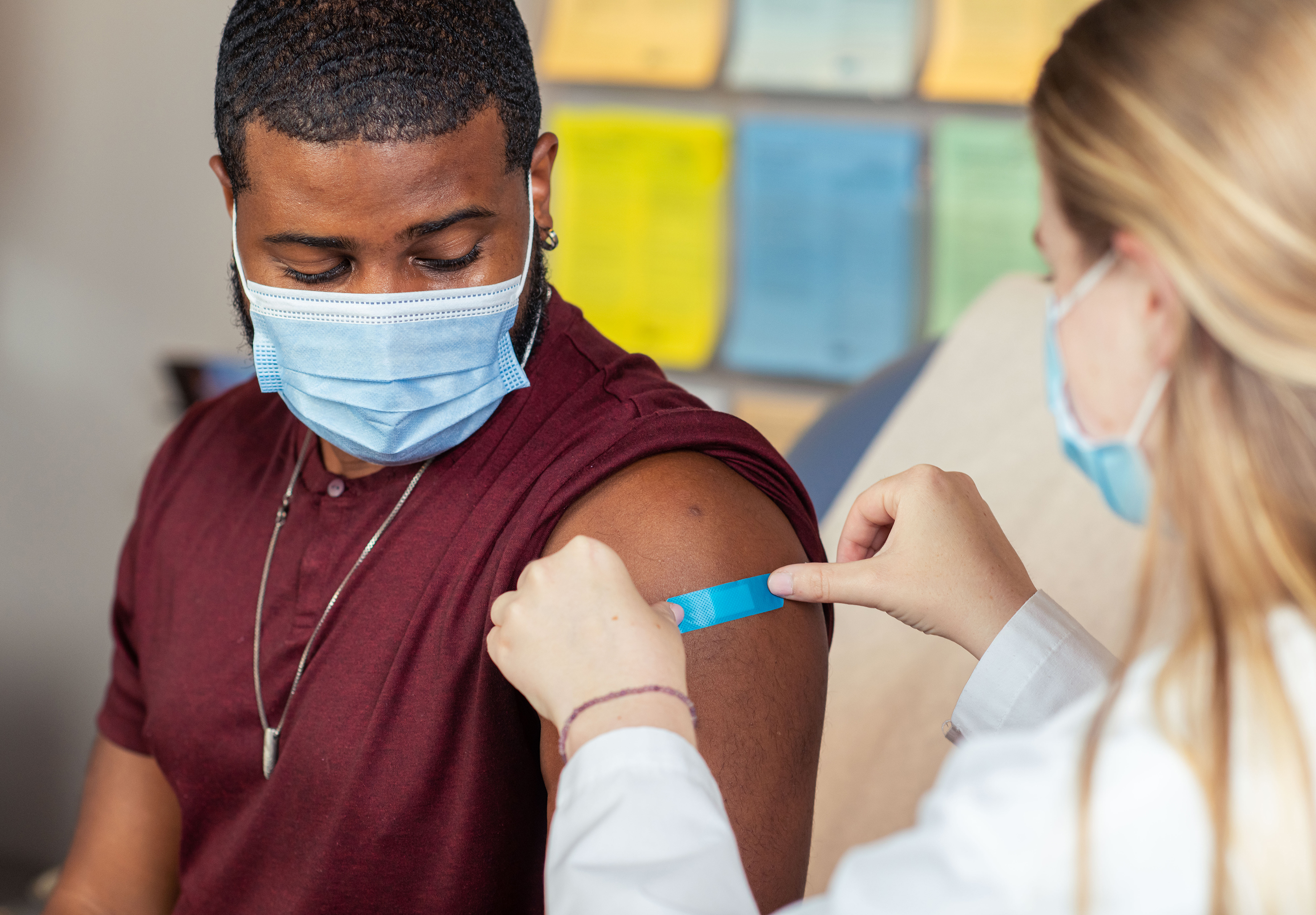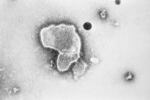
In this 2022 photo, a health care provider places a bandage on the injection site of a patient who just received an influenza vaccine. The best way to prevent seasonal flu is to get vaccinated every year.
Courtesy of Centers for Disease Control and Prevention
It’s that time of year again: stuffy noses ... barking coughs ... respiratory viruses going around.
Two in particular — the flu and RSV — are worth educating yourself about.
Like COVID-19, the flu and RSV cause lots of infections and are mild for most, but can cause more serious illness and hospitalization for anyone with a weakened immune system, including: very young children, pregnant people, adults 65 and up, and the immunocompromised.
Both viruses virtually disappeared during the COVID-19 pandemic, something state public health officials say they’d never seen before. The flu typically causes 12,000 to 52,000 deaths a year in the United States, and RSV is the leading cause of pneumonia in babies under one.
Experts are concerned that both viruses could be poised to make a major comeback this winter, but that’s not a foregone conclusion. Flu season in particular is difficult to predict. Here’s what to expect from RSV and the flu in Oregon.
Flu
What it is
Influenza, commonly known as flu, is a big family of viruses that transmit through breathing, coughing and sneezing. Two types in particular, Influenza A and Influenza B, cause most infections in humans. Each infected person tends to spread it to one or two others, making it much less transmissible than COVID-19.
How to know it’s flu
Symptoms include fever, cough, sore throat, runny or stuffy nose, body aches, headache, chills and fatigue. Vomiting and diarrhea is more common in children.
What we know about this year
With people gathering and returning to more normal behavior post COVID restriction, experts expect a more normal flu season and an increase in cases.
Flu activity in Oregon is minimal so far, according to the Centers for Disease Control and Prevention, but some states in the southern United States are reporting a lot of infections. This is normal — flu season usually starts later in Oregon than in other parts of the country.
Winter flu season in the southern hemisphere can be a bellwether for what to expect in the northern hemisphere. Dr. Melissa Sutton, medical director of viral respiratory pathogens at the Oregon Health Authority, said this year, it’s particularly difficult to glean clues as to what to expect.
Data from the southern hemisphere has been “all over the map,” with some places reporting high levels of flu and others reporting lower than typical flu levels, she said. Sutton said some of the variation may be due to underreporting of flu, with public health departments shifting focus toward COVID..
Reduce your risk
Flu vaccines are readily available and recommended for everyone 6 months and older. In Oregon, fewer people have gotten their annual flu vaccine than is typical this time of year.
Even if you’re not personally in an at risk group, getting vaccinated is a good way to reduce overall transmission of the flu and to help protect people who are at risk. Flu is known to cause pneumonia. The two conditions are responsible for around 500 deaths a year in Oregon, primarily in adults 65 and older, but often includes three or four pediatric deaths.
“The more people we can get vaccinated, the less we’ll see it spreading in our communities.” Sutton said.
There are several different flu vaccines available, including three higher dose options that are recommended, in particular, for people 65 and older who are at higher risk for complications.

FILE - This 1981 photo provided by the Centers for Disease Control and Prevention (CDC) shows an electron micrograph of Respiratory Syncytial Virus, also known as RSV. New research announced by Pfizer on Tuesday, Nov. 1, 2022, showed vaccinating pregnant women helped protect their newborns from the common but scary respiratory virus that fills hospitals with wheezing babies each fall.
CDC via AP, File / AP
RSV
What it is
Respiratory syncytial virus, or RSV for short, is a single virus that transmits through coughing, sneezing and touching contaminated surfaces. It’s usually mild and is one of the most common causes of a cold in children. In some cases though, it can cause lung infections like bronchiolitis or pneumonia, particularly in children under 2. Each infected person tends to spread it to three others — so it’s more contagious than flu, less contagious than COVID.
Most RSV infections go away on their own in a week or two and can be managed with proper nutrition, hydration, sleep and use of over-the-counter medication
Young children, especially those under 6 months, are more likely to experience complications. Preterm infants, infants with congenital heart or lung conditions, and infants with asthma are at the highest risk.
That’s in part due to their smaller airways and inability to blow their noses, said Eliza Hayes Bakken ‚a pediatrician and medical director of the pediatrics clinic at OHSU Doernbecher Children’s Hospital.
“Babies can literally look like they are kind of drowning in snot,” she said. “Suctioning them so they can get some breaths through their nose and they can feed a little bit better is one of our major interventions that we do for infants.”
How to know its RSV
Runny nose, decrease in appetite, coughing, sneezing, fever, wheezing and labored breathing are signs of RSV. Symptoms usually appear in stages, not all at once. In young infants with RSV, the only symptoms may be irritability, decreased activity and breathing difficulties, according to the CDC.
What we know about this year
Some states are reporting surges in RSV-related clinic and hospital visits. The Oregon Health Authority declared the official onset of RSV season last week based on the number of tests coming back positive.
Because RSV largely stopped spreading during the pandemic, Sutton said there’s likely a larger pool of kids being exposed to it for the first time.
“So essentially we’re worried that a broader range of ages might experience that severe disease,” Sutton said.
There’s also the phenomenon known as waning immunity, where lack of exposure to a virus can reduce antibodies and the immune response. It could affect nursing infants whose mothers’ immunity may have waned, making them less likely to pass protective antibodies through breast milk.
However, Hayes Bakken said parents shouldn’t put too much stock in news reports of surges in RSV. It’s normal for some RSV seasons to be bad and others mild. Furthermore, Hayes Bakken said if your child delayed getting RSV during the pandemic and is now coming down with it for the first time, that’s likely to their advantage.
“I would rather your healthy 3-year-old get RSV for the first time than your 2-month old,” she said. “The vast majority of kids who are having a tough time of it are the kids who have a tough time of it every year.”
Hayes Bakken also suspects that part of why so many more parents are bringing toddlers with RSV into clinics is because people who became new parents during the pandemic have less experience helping children get through fevers and respiratory viruses at home.
Reduce your risk
There is no vaccine for RSV, so people who want to avoid it should consider wearing a mask if they’re in a crowded indoor environment. If you live with a child under 2, having adults and older children in the household mask in crowded indoor environments can reduce the risk of transmission.
And if you have an infant under 6 months or a young child with underlying conditions, consider limiting the number of visitors in your household during RSV season. Hayes Bakken said she tells parents of young infants to minimize the number of people who come to meet the new baby and to avoid large gatherings. On the other hand, if there’s a small circle of family and friends helping out with the new baby, that’s worth the risk.
Hand washing is also a more effective and important tool against RSV transmission than it is for COVID and people are advised to wear a mask if they have a runny nose to keep others from getting sick.



